This study has reconsidered the link between fiscal policy and interest rates in Australia. Building on the work of Comley et al. (2002), we have examined the extent to which external factors drive movements in the interest margin between Australian and US real 10-year government bond yields. Specifically, the model incorporates Australian fiscal variables (primary balance and general government net debt) and a number of macroeconomic variables (the current account balance, GDP growth rate and inflation) that are expected to affect movements in the interest margin. The external influence on the real interest margin was considered by incorporating the US counterparts of these variables.
A general error correction model that incorporates both short- and long-run dynamics was specified and applied for two measures of the margin spanning the period 1990 to 2009. All else equal, the results suggest that, in the long run, the real interest margin rises by around three basis points in response to a one percentage point of GDP increase in the stock of Australian general government net debt, and by around ten basis points in response to a one percentage point of GDP decrease in US government net debt. In the short run, however, Australian fiscal variables do not have a statistically significant impact on the interest margin. Importantly, the results indicate that a number of US economic variables, namely inflation and the current account, exert the most powerful influence on the real interest margin.
A.1 Results of Comley et al. (2002)
Comley et al. (2002) investigated the potential link between fiscal policy and the real interest margin for Australian and US 10-year government bond yields, ![]() , over the period 1985 Q1 to 2001 Q2. The following set of explanatory variables was included in order to capture both long-term fundamentals and short-term influences on the interest margin:
, over the period 1985 Q1 to 2001 Q2. The following set of explanatory variables was included in order to capture both long-term fundamentals and short-term influences on the interest margin:
(2)
where:
![]() = structural budget balance (% of GDP);
= structural budget balance (% of GDP);
![]() = headline budget balance (% of GDP);
= headline budget balance (% of GDP);
![]() = net public foreign debt (% of GDP);
= net public foreign debt (% of GDP);
![]() = inflation;
= inflation;
![]() = real GDP growth; and
= real GDP growth; and
![]() = current account balance (% of GDP).
= current account balance (% of GDP).
This framework attempted to model a long-term equilibrium relationship where the level of the real interest margin is a function of the flow and stock effects of fiscal policy, controlling for the inflation rate, real GDP growth and public debt. Short-term changes in the real interest margin were hypothesised as a function of changes in the budget balance and stock of public debt controlling for changes in the same set of variables. Specifically, the real interest margin is expected to rise in response to a deterioration in the budget balance or a rise in the stock of public debt. The real interest margin is expected to be positively related to levels and changes in the inflation rate, and in the stock of public debt, but negatively related to levels and changes in GDP growth and the current account balance.
Table 3: Results of Comley et al. (2002)
| Coefficient | Implied long-run coefficient | |
| Explanatory variables: short run | ||
| Constant | -0.265 | |
| (1.09) | ||
| -0.327 | ||
| (2.35) | ||
| -0.200 | ||
| (2.64) | ||
| Explanatory variables: long run | ||
| -0.407 | ||
| (3.68) | ||
| 0.059 | 0.145 | |
| (2.83) | ||
| 0.041 | 0.101 | |
| (1.81) | ||
| -0.125 | -0.307 | |
| (2.74) | ||
| -0.071 | -0.174 | |
| (1.67) | ||
Note: 1985Q1 — 2001Q2. t-statistics in parentheses. The long-run coefficients are calculated by dividing the coefficients for the relevant variables by the coefficient on the error correction term (lagged value of the dependent variable).
Their results indicate that the real interest margin increases by around 20 basis points in response to a 1 per cent of GDP deterioration in the Australian headline budget balance in the short run. A one percentage point of GDP increase in the stock of Australian public debt was found to increase the long-run real interest margin by around 15 basis points.
For the other variables, a one percentage point of GDP increase in the Australian current account balance decreases the real interest margin by approximately 17 basis points in the long run, while an equivalent increase in the Australian inflation rate increases the margin by approximately 10 basis points. A one percentage point increase in the Australian real GDP growth rate decreases the long-run interest margin by approximately 31 basis points.
A.2 Data Definitions and sources
Interest margin
![]() — Indexed 10-year AUS government bond yield — Indexed 10-year US government bond yield. Source: Ecowin.
— Indexed 10-year AUS government bond yield — Indexed 10-year US government bond yield. Source: Ecowin.
![]() — Indexed 10-year AUS government bond yield — (Nominal 10-year US government bond yield — 5-year US inflation expectations, University of Michigan survey). Source: Ecowin.
— Indexed 10-year AUS government bond yield — (Nominal 10-year US government bond yield — 5-year US inflation expectations, University of Michigan survey). Source: Ecowin.
![]() —
— ![]() (1990
(1990
Q1-1996Q4), ![]() (1997Q1-2009Q4). Source: Ecowin.
(1997Q1-2009Q4). Source: Ecowin.
Explanatory variables
![]() — Australian primary budget balance, per cent of GDP. (Excludes net interest payments). Source: OECD economic outlook database (as of March 2010).
— Australian primary budget balance, per cent of GDP. (Excludes net interest payments). Source: OECD economic outlook database (as of March 2010).
![]() — US primary budget balance, per cent of GDP. (Excludes net interest payments). Source: OECD economic outlook database (as of March 2010).
— US primary budget balance, per cent of GDP. (Excludes net interest payments). Source: OECD economic outlook database (as of March 2010).
![]() — Australian general government net debt, per cent of GDP. Source: OECD Economic Outlook database (as of March 2010).
— Australian general government net debt, per cent of GDP. Source: OECD Economic Outlook database (as of March 2010).
![]() — US general government net debt, per cent of GDP. Source: OECD Economic Outlook database (as of March 2010).
— US general government net debt, per cent of GDP. Source: OECD Economic Outlook database (as of March 2010).
![]() — Australian inflation rate (average of the underlying measures and adjust for GST effects), through-the-year. Source: RBA Statistical Table G1.
— Australian inflation rate (average of the underlying measures and adjust for GST effects), through-the-year. Source: RBA Statistical Table G1.
![]() — US inflation rate (16 per cent trimmed mean), through-the-year. Source: Federal Reserve Bank of Cleveland.
— US inflation rate (16 per cent trimmed mean), through-the-year. Source: Federal Reserve Bank of Cleveland.
![]() — Australian real GDP growth rate, through-the-year. Source: ABS 5206.0 Australian National Accounts: National Income, Expenditure and Product, Dec 2009.
— Australian real GDP growth rate, through-the-year. Source: ABS 5206.0 Australian National Accounts: National Income, Expenditure and Product, Dec 2009.
![]() — US real GDP growth rate, through-the-year. Source: Ecowin.
— US real GDP growth rate, through-the-year. Source: Ecowin.
![]() — Australian current account balance, per cent of GDP. Source: ABS. 5302.0. Balance of Payments and International Investment Position, Dec 2009.
— Australian current account balance, per cent of GDP. Source: ABS. 5302.0. Balance of Payments and International Investment Position, Dec 2009.
![]() — US current account balance, per cent of GDP. Source: Ecowin.
— US current account balance, per cent of GDP. Source: Ecowin.
Chart 1: Real interest margin, indexed bond yields ![]()
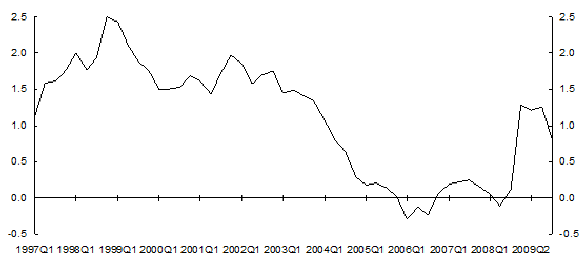
Chart 2: Real interest margin, indexed bond yields and US inflation expectations ![]()
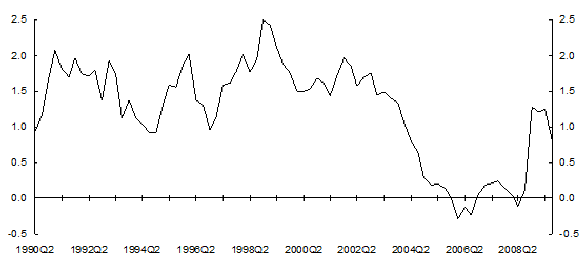
Chart 3: General government net debt
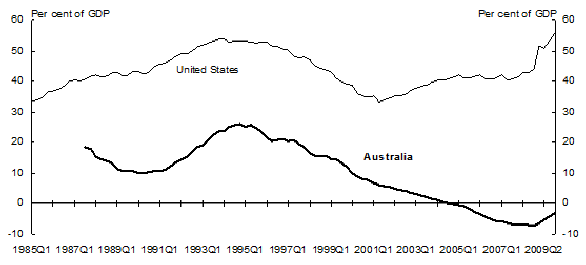
Chart 4: Primary budget balance
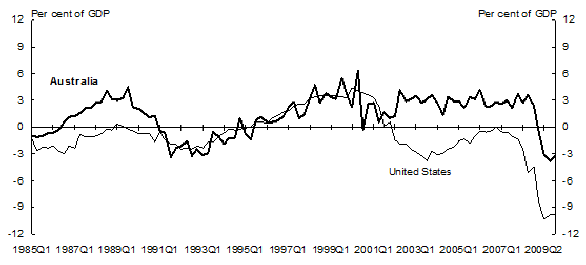
Chart 5: Current account balance
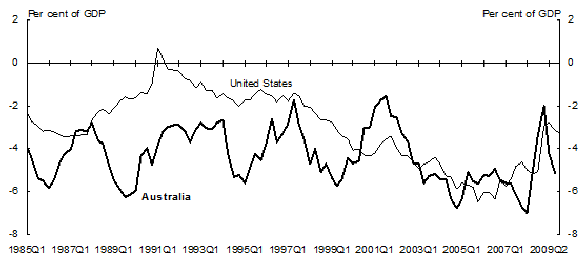
Chart 6: Inflation
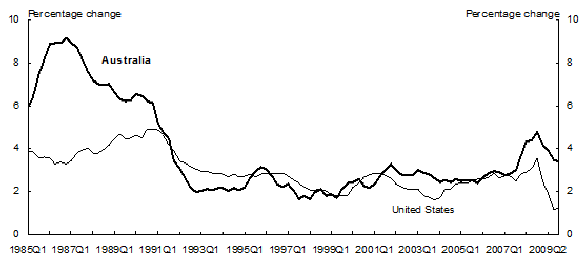
Chart 7: Real GDP growth
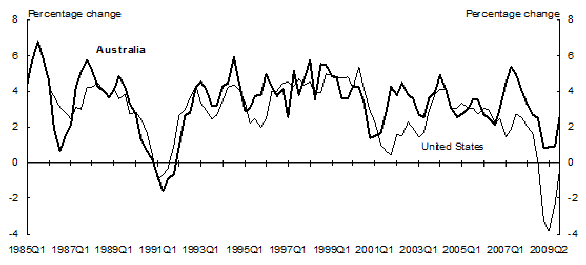
References
Ardagna, S. Caselli, F. and Lane, T. 2004, Fiscal discipline and the cost of public debt service: Some estimates for OECD countries, B.E. Journal of Macroeconomics: Topics in Macroeconomics, 2007, 7(1).
Ardagna, S. 2009, Financial markets’ behaviour around episodes or large changes in the fiscal stance, European Economic Review, 53, 37-55.
Baldacci, E. and M. S. Kumar. 2010, Fiscal Deficits, Debt and Interest Rates, IMF Working Paper, forthcoming, International Monetary Fund, Washington, D.C.
Barro, R. J. 1974, Are Government Bonds Net Wealth?, Journal of Political Economy, 82, 1095 1117.
Barro, R. J. 1991, World Interest Rates and Investment, Working Paper No. 3849, National Bureau of Economic Research, Cambridge, Massachusetts.
Barth, J. R. Iden, G. Russek, F. S. and Wohar, M. 1991, The Effects of Federal Budget Deficits on Interest Rates and the Composition of Domestic Output, in, The Great Fiscal Experiment, eds, Penner, R. G. 69-142, Urban Institute Press, Washington D.C.
Canzoneri, M. B. Cumby, R. E. and Diba, B. T. 2002, Should the European Central Bank and the Federal Reserve Be Concerned About Fiscal Policy?, Presented at the Federal Reserve Bank of Kansas City symposium, Jackson Hole, Wyoming.
Chinn, M. and Frankel, J. 2005, The Euro Area and World Interest Rates, Working Paper Series, No. 1031, Department of Economics, University of California, Santa Cruz.
Cohen, D. and Garnier, O. 1991, The Impact of Forecasts of Budget Deficits on Interest Rates in the United States and Other G7 Countries, Board of Governors of the Federal Reserve System.
Comley, B. Anthony, S. and Ferguson, B. 2002, The effectiveness of fiscal policy in Australia — selected issues, Economic Roundup, Winter 2002, 45-72, Canberra.
Commonwealth of Australia. 2010, Budget Paper No. 1, Budget Strategy and Outlook 2010-11, Commonwealth of Australia, Canberra.
Elmendorf, D. W. and Mankiw, N. G. 1999, Government Debt, in, Handbook of Macroeconomics, vol 1C, eds, Taylor, J. B. and Woodrod, M. 1615-69, Elsevier Science, Amsterdam.
Engen, E. and Hubbard, R. G. 2004, Federal Government Debts and Interest Rates, Working Paper No. 10681, National Bureau of Economic Research, Cambridge, Massachusetts.
European Commission 2004, Public Finances in EMU, Brussels.
Gale, W. G. and Orszag, P. 2003, Economic Effects of Sustained Budget Deficits, National Tax Journal, vol. 56(3), 463-485.
Hamilton, J. D. 1994, Time Series Analysis, Princeton University Press, Princeton.
Horton, M. Manmoham, K. and Mauro, P. 2009, The State of Public Finances: A Cross-Country Fiscal Monitor, IMF Staff Position Note 09/21, IMF, Washington D.C.
International Monetary Fund 2010, Fiscal Monitor: Navigating the Fiscal Challenges Ahead, World Economic and Financial Surveys, IMF, Washington D.C.
Kirchner, S. 2007, Fiscal Policy and Interest Rates in Australia, Policy, 23(3), 11-14.
Laubach, T. 2003, New Evidence on the Interest Rate Effects of Budget Deficits and Debt, Finance and Economics discussion Series 2003-12, Board of Governors of the Federal Reserve System, May.
Lee, J. and Strazicich, M. 2003, Minimum Lagrange multiplier unit root tests with two structural breaks, Review of Economics and Statistics, 81, 1082-1089.
OECD 2009, Interim Eco
nomic Outlook, Chapter 3: The Effectiveness and Scope of Fiscal Stimulus, OECD, Paris.
Reinhart, V. and Sack, B. 2000, The economic consequence of disappearing government debt, Brookings Papers on Economic Activity, 2, 163-209.
Röhn, O. 2010, New evidence on the private saving offset and Ricardian equivalence, OECD Economics Department Working Papers, No. 762, OECD Publishing, Paris.
Thomas, L. B. and Wu, D. 2009, Long-term interest rates and expected future budget deficits: evidence from the term structure’, Applied Economics Letters, 16(4), 365-68.
7 We note that the limited size of the sample implies some caution against putting undue emphasis on our point estimates.
8 The five year inflation expectations series is obtained from the University of Michigan’s Surveys of Consumers.
9 A third alternative would have been to calculate the real interest margin using nominal bond yields and inflation data. However, this alternative is less desirable given uncertainties about the relationship between inflation expectations and actual inflation. In addition, using this measure would make it difficult to distinguish between real and nominal impacts on the yield spread given that inflation is one of the explanatory variables.
10 The variables included in the table are statistically significant at a 5 per cent significance level.
11 However, we note the relatively small sample size makes it difficult to test for unit roots with high precision.